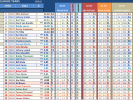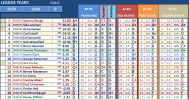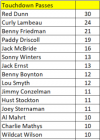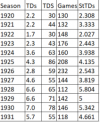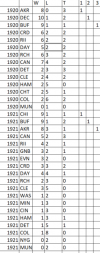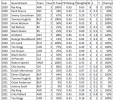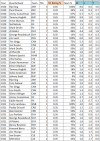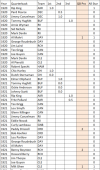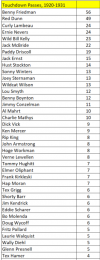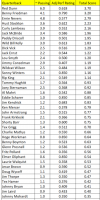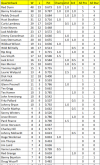- Joined
- Apr 3, 2006
- Messages
- 26,101
- Reaction score
- 52,115
So here's the application of the new peak score. A before-and-after would be good here, but here's what it looks like. As suspected, (the impetus for this change), Unitas moves up and Starr moves down. Marino separates from Griese. It solves a lot of problems down the list. Jim McMahon and Joe Theismann are no longer coming up as a Hall of Fame snubs.
Also, I gave a friend of ours a 0.1 passer rating for now to move him down the list so he wouldn't destroy constructive discussion about the top of the list. I think the top tends to dominate how we see the rankings system...but a lot of the bigger issues (believe it or not) are less fixable than adjusting playoff weight to push Manning down or emphasizing era rating to push Young up.
The only guys outside the Hall of Fame predictive index here are Namath and Blanda, which tells me that, for a Hall of Fame monitor, the AFL accomplishments are vasly overrated. They're not only getting full credit for their accomplishments but I think also getting like 2X or 3X the weight because of historical factors.
This is also the first time I think Eli is about where he should be.
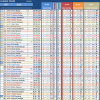
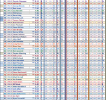
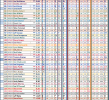

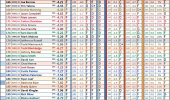
Also, I gave a friend of ours a 0.1 passer rating for now to move him down the list so he wouldn't destroy constructive discussion about the top of the list. I think the top tends to dominate how we see the rankings system...but a lot of the bigger issues (believe it or not) are less fixable than adjusting playoff weight to push Manning down or emphasizing era rating to push Young up.
The only guys outside the Hall of Fame predictive index here are Namath and Blanda, which tells me that, for a Hall of Fame monitor, the AFL accomplishments are vasly overrated. They're not only getting full credit for their accomplishments but I think also getting like 2X or 3X the weight because of historical factors.
This is also the first time I think Eli is about where he should be.









